Key takeaways:
- Selective mutism is an anxiety disorder affecting children’s ability to speak in certain social situations; emotional support and understanding are crucial.
- Speech encouragement through gentle methods and creating safe environments can lead to significant improvements in communication.
- Effective strategies for parents include fostering a relaxed home atmosphere, involving siblings, and using visual aids to support speech development.
- Therapists play a vital role by using techniques like gradual exposure and play therapy to help children express themselves comfortably.
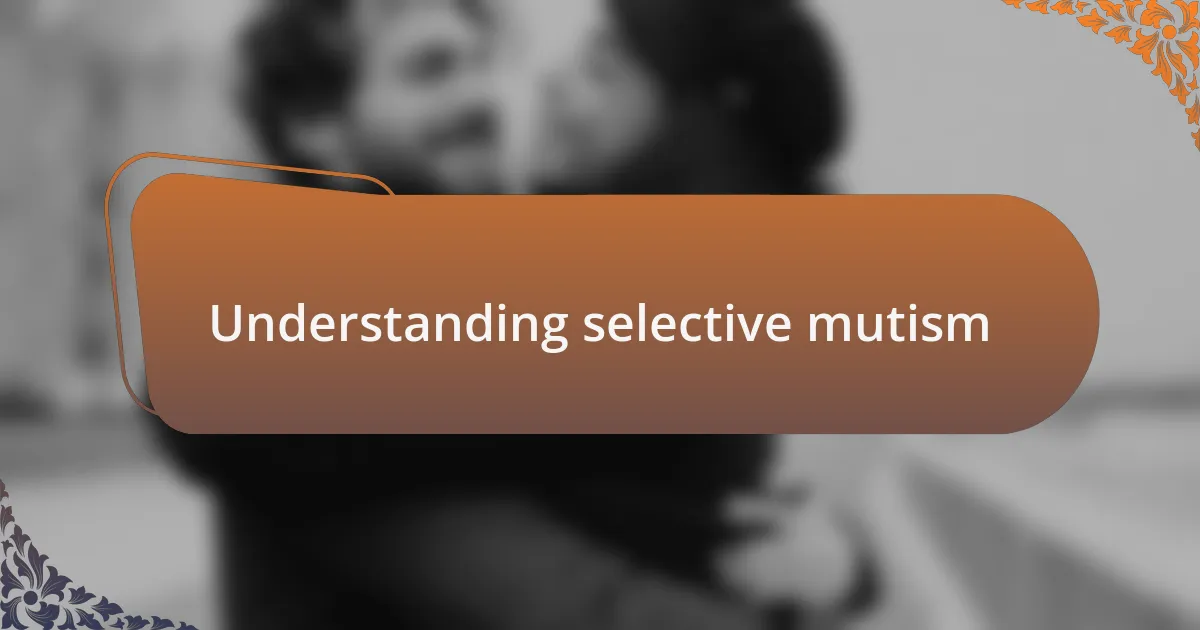
Understanding selective mutism
Selective mutism is a complex anxiety disorder that primarily affects children, making it difficult for them to speak in certain social situations despite being able to communicate effectively in comfortable environments, like at home. Reflecting on my experience, I remember a child who would light up during playtime but would retreat into silence when faced with a classroom full of peers. Why does this happen? It’s often rooted in intense shyness or fear, showing that communication barriers can be more mental than physical.
The emotional toll of selective mutism can be profound, both for the child and their family. I recall a mother expressing her frustration and sadness as her daughter, who excelled in expressing herself through art, struggled to share her thoughts verbally with others. It makes me wonder, how can we foster an environment where such children feel safe to find their voices? Understanding their perspective is key; supportive and patient approaches can make all the difference.
Moreover, it’s essential to recognize that selective mutism is not a choice. It can lead to feelings of isolation and confusion for the affected individuals, often leaving them feeling misunderstood. I often think about how important it is for those around them to cultivate empathy and be aware of these silent battles, as it can empower these children to eventually speak out in their own time. The journey towards communication can be slow, but it can also be hugely rewarding when nurtured delicately.
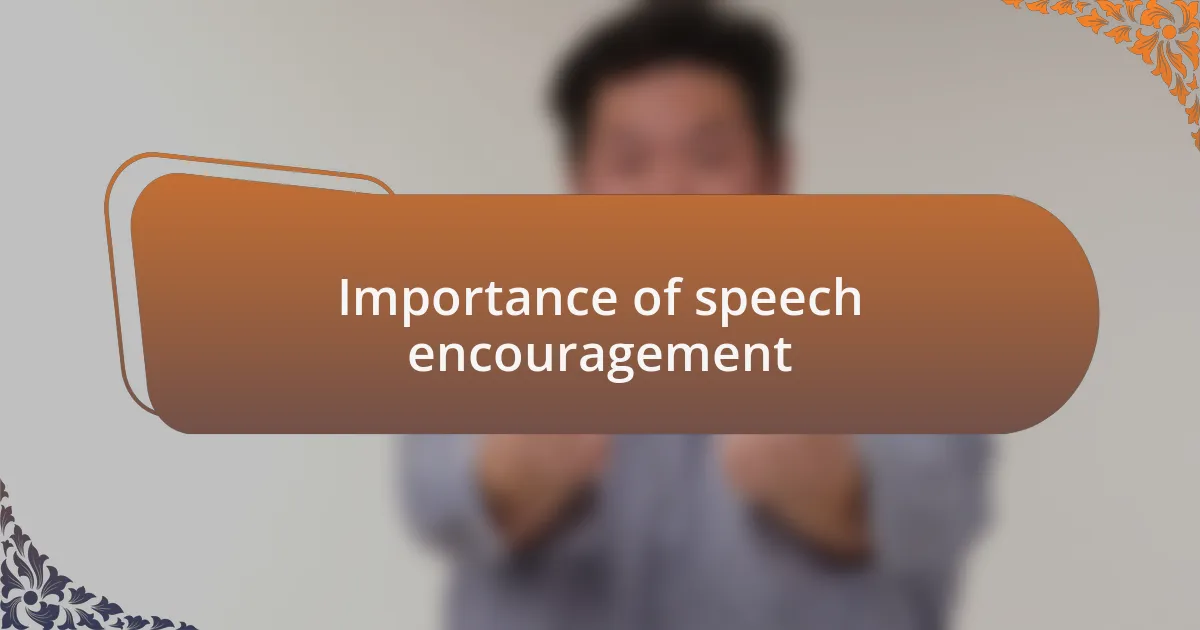
Importance of speech encouragement
Speech encouragement plays a pivotal role in helping children with selective mutism gradually find their voices. I once supported a child who could only whisper in therapy sessions but thrived during one-on-one interactions with trusted adults. It made me realize that consistent, gentle encouragement from caregivers and educators can be transformative, creating a safe space for children to express themselves without the weight of judgment.
I often reflect on the power of small victories in fostering communication. For instance, I remember a parent who celebrated her child’s first vocal attempt in a group setting. That simple act of recognition not only boosted the child’s confidence but also inspired others in the room to engage more openly. How can we highlight these milestones to keep the momentum going? Each small step can build not just skills but also a sense of belonging.
Moreover, understanding that encouragement should be tailored to an individual’s comfort levels is crucial. There was a time when a young girl I worked with preferred to communicate through drawings rather than speech. It became clear to me that integrating her art into our sessions not only respected her boundaries but also encouraged her to gradually venture into verbal communication. Isn’t it fascinating how finding personal connections can enhance the way we encourage speech? Each effort contributes to a more profound understanding and connection, paving the way for true expression.
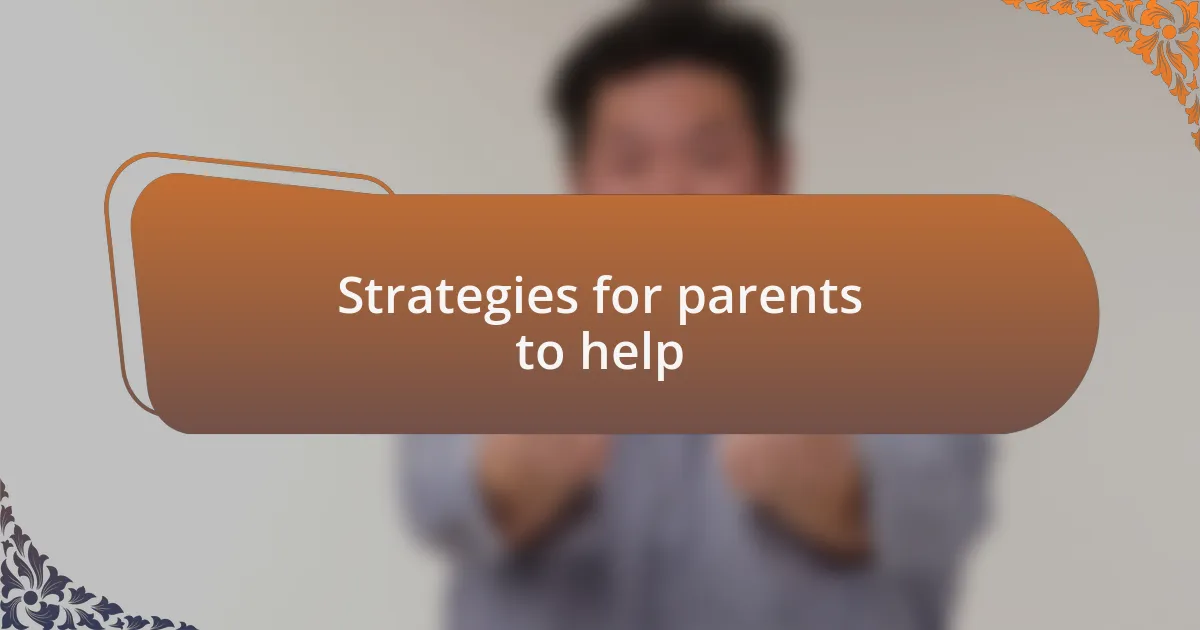
Strategies for parents to help
Encouraging speech in children with selective mutism requires a variety of thoughtful strategies. One approach I found effective was creating a relaxed environment at home. For example, I once advised a family to establish a regular reading time where the child could hear their favorite stories. Over time, I noticed that the child became more comfortable vocalizing parts of the story, even if it was just a single word or phrase at first. Isn’t it amazing how the right setting can make a child feel freer to explore their voice?
Another strategy I often recommend is involving siblings in the process. When I worked with a family where the older sibling took an active role in encouraging conversation, the dynamic shifted dramatically. They would create games where speaking was part of the fun. Through this approach, I observed that it not only deepened their bond but also made the quieter child feel less pressured. How can siblings play a role in fostering communication and connection?
In addition, I believe that using visual aids can be incredibly helpful. I once introduced picture cards to a child who struggled with verbal expression. These cards depicted various emotions and activities, serving as prompts during our interactions. As I watched the child associate words with visuals, I could see a spark of understanding and excitement. What better way to bridge the gap between silence and speech than by tapping into the child’s interests and allowing them to choose what to express?
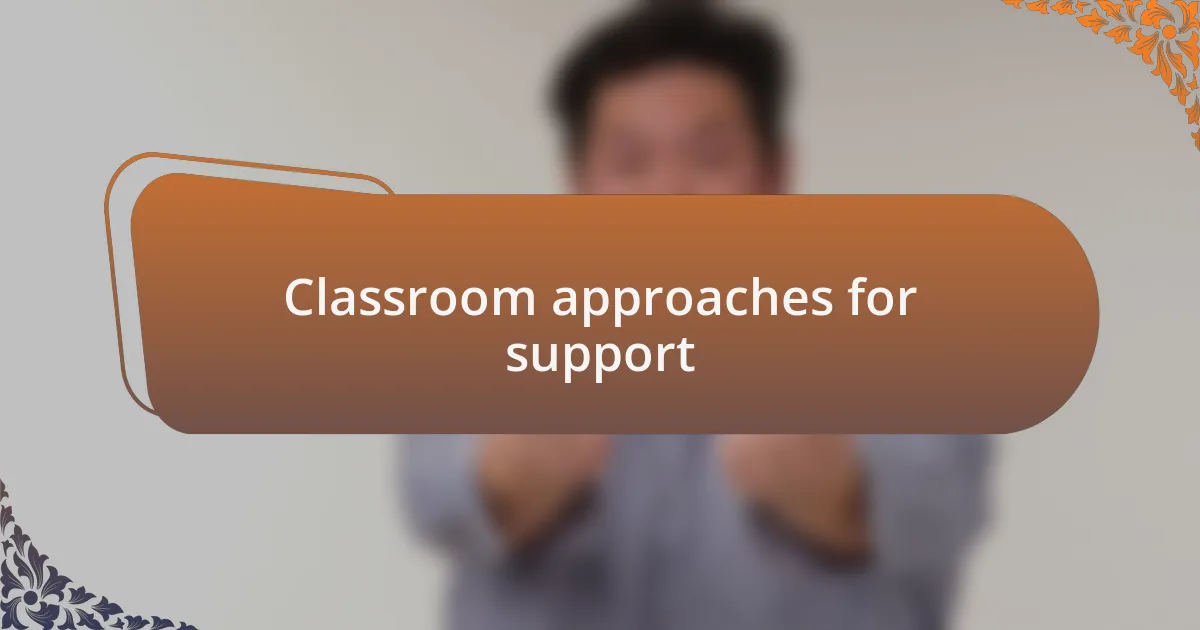
Classroom approaches for support
Creating a supportive classroom environment is essential for children with selective mutism. One memorable experience I had was when a teacher implemented ‘talking buddies’ for students who struggled to engage. They paired the child with a peer who was friendly and approachable, allowing them to practice small conversations in a non-threatening way. I witnessed the child’s confidence grow, slowly transitioning from silence to sharing their thoughts in class discussions. Isn’t it powerful how a little peer support can have such a profound impact?
Incorporating routine check-ins is another effective classroom strategy. I remember how a teacher dedicated just five minutes each day for one-on-one chats with students. This simple approach created a safe space for the child to express themselves without the pressure of a larger audience. Over time, it was gratifying to see the child start to respond, sometimes even offering thoughts on the day’s lesson. How can small, consistent moments of connection lead to leaps in communication?
Finally, I’ve found that using technology can be a game-changer. Once, I introduced a speech app to a classroom where a child felt too shy to speak. The app allowed them to communicate through text or recordings, and over several weeks, they became more comfortable sharing their voice in real-time during discussions. The excitement I saw in the child’s eyes when they confidently voiced their opinion during a class debate was truly unforgettable. Isn’t it fascinating how innovative methods can unlock potential?

Role of therapists in treatment
Therapists play a critical role in the treatment of children with selective mutism, fostering an environment where they can learn to find their voice. I’ve seen how a therapist might introduce gradual exposure techniques, gently encouraging children to speak in low-pressure situations. I recall a therapy session where a child was asked to whisper their favorite toy’s name to their therapist, and witnessing that breakthrough moment was simply uplifting. How often do we underestimate the power of gentle encouragement?
Additionally, therapists often collaborate with parents and educators, crafting a holistic approach. In one case, a therapist organized a workshop for parents to share strategies and successes, creating a support network. Seeing parents connect over shared experiences made me realize the importance of community in this journey; who wouldn’t feel strengthened by knowing they’re not alone?
Moreover, play therapy can be particularly effective. I once observed a session where a child communicated through stories and puppets rather than speaking directly. This creative approach allowed the child to express thoughts without the pressure of verbal communication, and it struck me how powerful it can be to communicate in a way that feels safe. Have you ever considered how different modalities can open avenues for expression that traditional methods might miss?
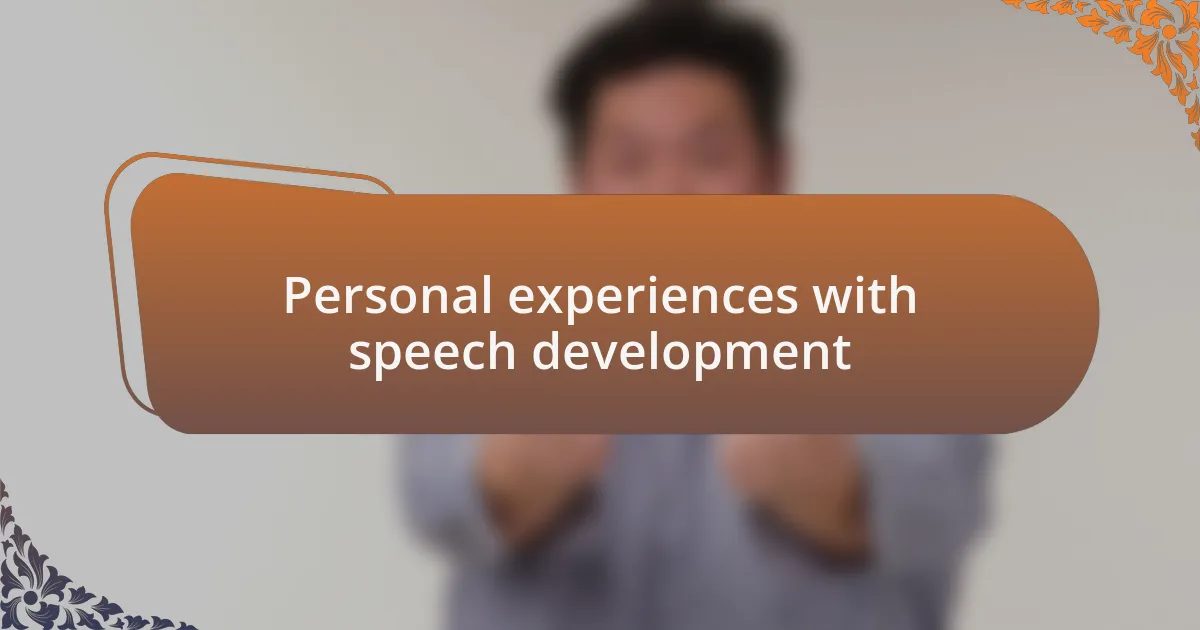
Personal experiences with speech development
Many moments in my life have been shaped by my own experiences with speech development. I remember being a child who struggled to articulate my thoughts, often feeling overwhelmed in social settings. It was as if my words were trapped, waiting for the perfect moment to escape. Have you ever felt that pressure to speak when all you want to do is listen?
When I finally found my voice, it was through small, supportive interactions that encouraged me to express myself. I vividly recall a supportive teacher who celebrated every attempt I made to communicate, even if it meant just nodding or pointing at times. It taught me that every word counts, and that feeling heard, no matter how it happens, can instill a sense of confidence that propels speech development.
Reflecting on those early days, I recognize the importance of patience in the process. There were setbacks that made me question if I would ever find my rhythm, but each little victory fueled my desire to engage more. Looking back, I realize those early struggles were invaluable lessons; isn’t it amazing how our challenges can shape our growth in such profound ways?
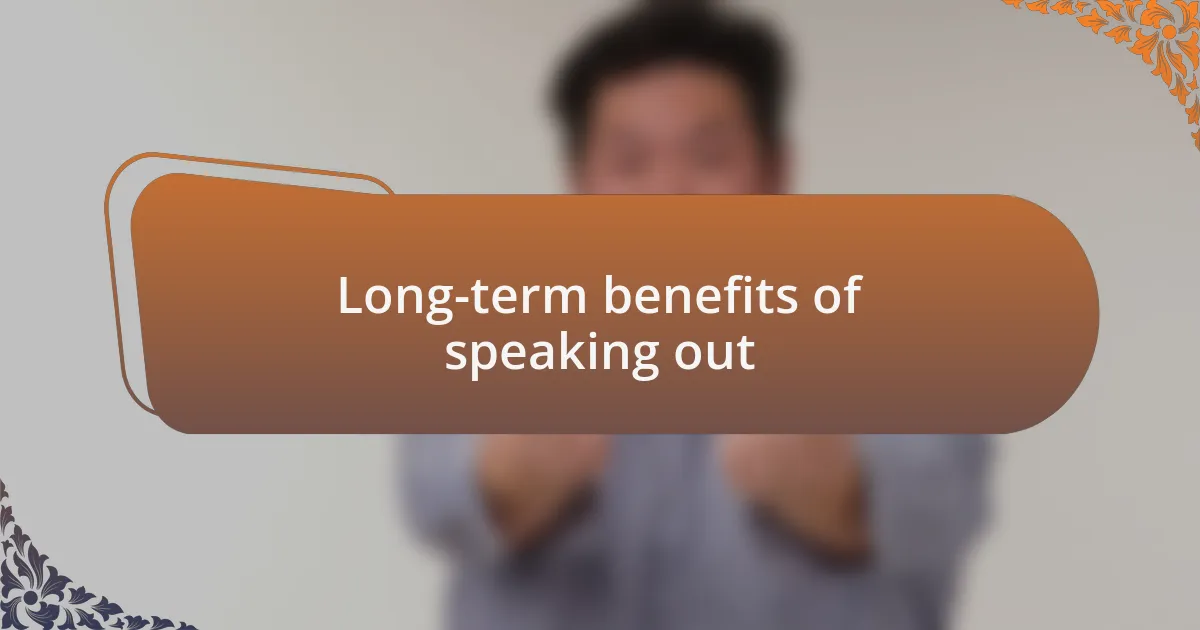
Long-term benefits of speaking out
Speaking out can lead to remarkable long-term benefits, especially for those who have faced challenges like selective mutism. I once mentored a young girl who rarely spoke in school, but when she began to share her feelings, I saw a noticeable transformation. She became more confident and willing to engage with her peers, proving that even small steps in communication can significantly impact one’s social life and self-esteem.
When I think about the power of voice, I remember one of my own key moments—when I stood up during class and expressed my opinion on a topic for the first time. My heart raced, but the encouragement I received afterward was incredible. It dawned on me that speaking out not only fosters connections but also strengthens your identity, allowing you to present a more authentic version of yourself to the world.
Over time, the ability to articulate thoughts and feelings can lead to a deeper understanding of oneself. Have you ever noticed how sharing your experiences can create bonds with others who feel the same? I found that in hearing responses from others, I was able to reflect on my own journey and grow in unexpected ways, reinforcing the idea that speaking out is not just about communication but about building lasting relationships and enhancing emotional health.